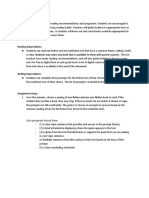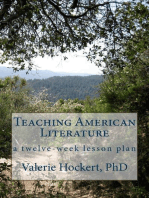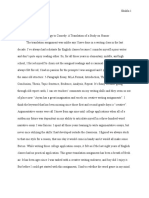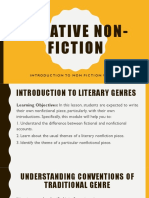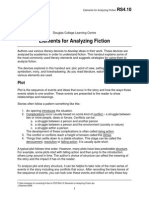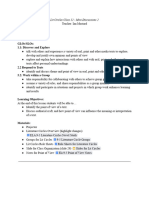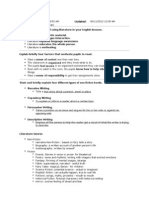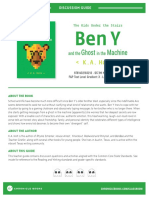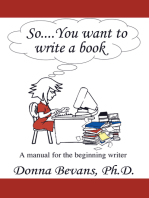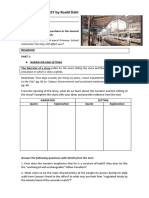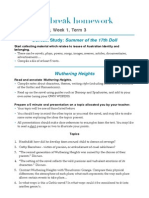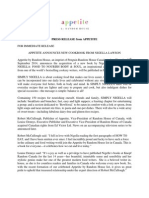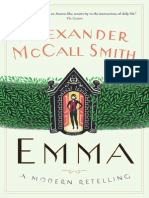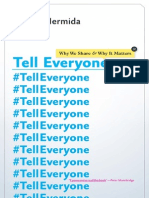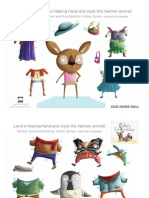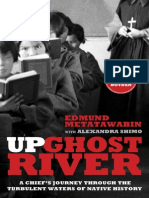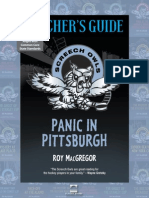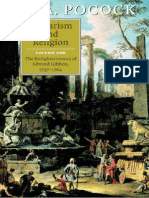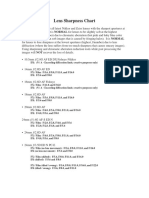Professional Documents
Culture Documents
The Reluctant Journal of Henry K. Larsen Guide
Uploaded by
Random House of CanadaCopyright
Available Formats
Share this document
Did you find this document useful?
Is this content inappropriate?
Report this DocumentCopyright:
Available Formats
The Reluctant Journal of Henry K. Larsen Guide
Uploaded by
Random House of CanadaCopyright:
Available Formats
www.tundrabooks.com www.facebook.
com/TundraBooks @TundraBooks
Susin Nielsen
1
THE RELUCTANT JOURNAL
of HENRY K. LARSEN
SUSIN NIELSEN
EDUCATORS GUIDE
TUNDRA BOOKS
www.tundrabooks.com
www.tundrabooks.com www.facebook.com/TundraBooks @TundraBooks
Susin Nielsen
1
PRE-READING DISCUSSION
1. Teachers: Introduce the narrative mode (and point of view)
that the author uses to tell the story. Conduct a classroom
discussion with the following prompts:
Have you ever written in a journal? If so, why did yo
write in the journal? If not, why do you think others may
want to write in a journal?
Can you think of any other novels that have been written
in this way? Or any novels that included journal writing
as a part of the narrative?
What are some common elements of a journal entry?
(Written in frst person, dated, sequential, etc.)
2. Look up the meaning of reluctant in the dictionary. Why
do you think the novel is called, The Reluctant Journal of
Henry K. Larsen?
3. As a class, create a mind map of what the students think of
when they hear the word, bully. This mind map will be
revisited later to see how their thinking has evolved or
changed.
Susin Nielsen has created a fantastic new character in Henry,
whose journal entries are infused with humor and provide a
riveting read about a family in turmoil. The novel explores a
very real problem plaguing every school campus across North
America: bullying. A sensitive and emotionally charged topic,
Susin Nielsens book can be used as an important springboard
for the classroom and whole school conversations that need
to occur if appropriate action is to be taken to eliminate bul-
lying behavior from our schools.
Teachers can use the text in a number of ways, including:
Exploring conceptual and thematic connections such as
acceptance, family, forgiveness, friendship, healing,
humor and perspective
Investigating frst person narrative vs. third person
narrative
Conducting an in-depth study of character development
Exploring both the overt and hidden aspects and
consequences of bullying behavior.
The activity guide that follows includes discussion questions,
writing activities and prompts to elicit a meaningful under-
standing of the text. Where applicable, activities have been
aligned with Common Core State Standards. The activities
can be used for a Social Studies and Language Arts unit or
can be used as stand alone enrichment in whole class and/or
small group novel studies.
DEAR EDUCATOR
Thirteen-year-old Henrys happy, ordinary life comes to an
abrupt halt when his older brother, Jesse, picks up their fathers
hunting rife and leaves the house one morning. What follows
shatters Henrys family, who are forced to resume their lives
in a new city, where no one knows their past. When Henrys
therapist suggests he keep a journal, at frst he is resistant. But
soon he confdes in it at all hours of the day and night.
In spite of Henrys desire to fy under the radar, he eventu-
ally befriends a number of oddball characters, both at school
and in his modest apartment building. And even though they
know nothing about his pastat least, not yetthey help him
navigate the waters of life after IT.
Susin Nielsen peoples this novel about the ultimate cost of
bullying with a cast of fabulous characters, dark humor and a
lovable, diffcult protagonist struggling to come to terms with
the horrible crime his brother has committed.
ABOUT THE BOOK
www.tundrabooks.com www.facebook.com/TundraBooks @TundraBooks
Susin Nielsen
2
What does the phrase, there are two sides to every story
mean? This novel is told from the perspective of Henry
through his journal entries. Journal entries are typically
written in frst person and refect the personal thoughts
and feelings of the writer. Using the T-chart provided,
brainstorm three advantages and three disadvantages of
telling a story using this type of narration.
Why do you think the author chose to tell the story in this
manner? Do you agree with the authors decision to use
this narrative technique? Support your opinion citing at
least three reasons for your thinking.
How would telling the story in frst person traditional nar-
ration differ from telling the story in frst person narration
through journal entries? (Hint: think of past and present
tenses.)
(RL.6.6, RL. 7.6)
LEARNING ACTIVITIES
1. MY RELUCTANT JOURNAL
Teachers: As your students read the novel, either as a class,
in small groups or individually, allow them to keep a readers
response journal. Since the book is not divided up into chap-
ters but rather journal entries, a good rule of thumb is that stu-
dents should be making an entry in their journal after reading
every twenty pages or so. The journal can be a traditional pen
and paper book, typed on a computer or can take the form of
an online blog.
Some guiding prompts for your students to consider when
writing include:
How has the plot advanced?
Were any new characters introduced?
Was there any new vocabulary?
Did the story remind me of anything? Did I make any
personal connections? Did I have an emotional response
to what happened?
What will happen next?
What do I hope will happen next?
Was my prediction correct from my last journal entry?
Do I have any questions about what I read?
2. THERE ARE TWO SIDES TO EVERY STORY
3. RELIABLE VS. UNRELIABLE NARRATION
Narrators can be reliable, unreliable or sometimes both
within the same story. What is a reliable narrator? What is
an unreliable narrator? Can you think of an example of an
unreliable narrator?
Do you think that Henry was a reliable or unreliable
narrator? Explain your thinking.
How might the story be different had it been told in third
person narration? Support your opinion citing at least
three reasons for your thinking.
(RH.6-8.6)
4. CHANGING PERSPECTIVES
Select one major event from the story. Reread Henrys
journal entry describing that event. Write a new journal
entry describing the same event from the perspective of
one of the other characters involved. How might this affect
the way a reader understands and processes that event?
Select an event or series of events from the story. Without
looking at the text, rewrite the event in third person narra-
tive. Try to include details that were not in Henrys journal
entries, but dont change any essential details of the plot.
Again, how might this affect the way a reader interprets
the events of the novel?
(RL.5.6, W.6.3)
5. CHARACTER TRAITS
Journal entries allow the reader to get a personal glimpse
into a characters thoughts and feelings. What are three
character traits Henry displays that although not explicitly
described in the text, are evident from reading his journal
entries? Use the graphic organizer provided to organize
your thoughts and provide proof of your thinking.
(RL.6.1, RL.7.1)
6. HUMOR
Although the novel deals with some very serious themes,
there is quite a bit of humor in many of Henrys journal
entries. Locate three examples of humor in the text.
Why do you think the author chose to write about the
GWF and not some other sport? What role did it play in
the narrative?
(RL.6.4)
www.tundrabooks.com www.facebook.com/TundraBooks @TundraBooks
Susin Nielsen
3
11. CHANGING OUTCOMES
Henrys parents blamed each other for what happened
with Jesse. Henry himself felt responsible. Do you think
the tragedy in the novel could have been prevented? If so,
how? If not, why not? Refer to characters and events in the
story to support your reasoning.
(RL.6.1)
7. SYMPATHY VS. EMPATHY
Using a dictionary, describe the difference between the
words, sympathy and empathy.
Jodie was Henrys best friend before he moved to Van-
couver. They had a special friendship. In what way might
these two characters sympathize and empathize with one
another?
Think about how Jesses actions would have impacted
Jodie and Henry. How might they have similar and dif-
ferent feelings as a result of the same event? Use the Venn
diagram provided to record your thoughts.
Scott, Jesses bully, was also Jodies older brother. Jodie
looked up to her brother. Why do you think the author
chose to show this gentler side of the bully, instead of just
focusing on his negative qualities? Write a paragraph in
which you either question or support this portrayal.
(W.5.1, L.6.4c)
LEARNING ACTIVITIES
(CONTINUED)
8. HEALING
Karen was one of Henrys neighbors in the building. The
frst few times that they met, Henry and Karen did not like
each other. Over time, Henry came to somewhat rely on
Karen to help him heal. Discuss the evolution of their re-
lationship and how ultimately, they may have helped each
other heal from their personal trauma.
(RL.6.4)
Look up the word, stereotype in the dictionary. Record
the defnition in your own words and give an example.
What was Henrys frst impression of Farley? What did
he base this impression on? Find examples in the text to
support your answer.
How did Henrys feelings about Farley change over the
course of the novel? What made him change his mind?
What lesson can be learned from the development of
Henrys friendship with Farley?
Locate and quote three other examples in the story where
Henry stereotyped people. Explain in writing, citing ex-
amples from the text, how Henrys thinking changed about
these three characters, and as a result, how his behavior
changed throughout the story. Use the graphic organizer
provided to organize your thinking.
(RL.6.1, RL.6.3, L.6.4c, RL.7.2)
9. CHARACTER DEVELOPMENT
10. BULLIES, VICTIMS, AND BYSTANDERS
Write a short paragraph that explains what it means to be
bullied. Share your writing in small groups, and then to-
gether use the graphic organizer provided to brainstorm
the different forms bullying can take. Keep in mind that
not all bullying can be easily observed. What kind of bul-
lying took place in the novel?
Have you or somebody you know ever been a victim of
bullying? In a private journal-style entry of your own, write
about this experience or what you know of somebody
elses experience. If you dont know of somebody person-
ally, you can write about a character in the novel. You may
choose to share this journal entry with classmates or keep
it private. How did the bullying make you or the victim
feel?
When somebody is bullied, the only people involved are
the bully and the victim. In partners, discuss this state-
ment. Do you agree with it? Why/why not?
Bullying affects more than the victim alone and can have
far-reaching consequences. List all of the people affected
by bullying in the novel, both the aggressors and the vic-
tims, and those not directly involved in the bullying but
still impacted by it (teachers, siblings, bystanders, etc.).
Use the three-column T-chart provided to record your list.
There were people who were aware that Jesse was a victim
of bullying. Why do you think that they didnt intervene?
Choose three different characters in the novel that were in
a position to know about Jesses struggles, and think about
why they werent able to, or chose not to, help. Using a
think-pair-share, discuss your thinking with your class-
mates.
(W.6.3d)
www.tundrabooks.com www.facebook.com/TundraBooks @TundraBooks
Susin Nielsen
4
LEARNING ACTIVITIES
(CONTINUED)
13. HAIKU
One of Henrys journal entries recounts the poems he
wrote for English class on Valentines Day. Haikus, as
Henry explains, are . . . super-short poems, unrhymed
frst line, fve syllables; second line, seven syllables, third
line, fve syllables. Compose a haiku of your own about
one aspect of the novel that had an impact on you.
14. REACH FOR THE TOP!
In small groups, create a Reach for the Top trivia game
with questions about the novel. Include questions about
plot, characterization, narrative mode and questions about
the author.
Combine small groups and challenge each group to play
the others Reach for the Top trivia game!
2. MEMORY BOX
Henry and Jesses mom kept a memory box full of keep-
sakes from their childhood. Everything included in the box
had a special memory attached to it. If you were to cre-
ate a memory box from your childhood, what would you
include in it? Use a shoebox and collect items that are
important to you. If you dont want to include an item,
or you dont have the item anymore, draw a picture of it
and include it in your box. Alternatively, create a virtual
memory box with pictures and images that represent your
special memories. Present your memory box in partners,
small groups, or to the class.
3. RECYCLING IN THE COMMUNITY
Henry and Farley collect cans and bottles from their school
recycling bins to raise money so they can buy tickets to the
GWF show. Research the local recycling program in your
community and prepare a short slideshow presentation or
poster board that outlines the different stages involved in
recycling cans and bottles in your community, beginning
with when the bottle or can is frst thrown away.
(W.6.7)
WRAP UP DISCUSSION QUESTIONS
1. Revisit the bully mind map created in the pre-reading ac
tivities. Is there anything you would now omit or include in
the mind map?
2. Has your thinking changed at all with respect to bullying in
schools? If so, how? If not, did the story confrm any of
your previous beliefs?
3. In order to refect on the novel, allow students the
opportunity to review what they have written in their
reluctant journals and to share their writing with their peers.
1. THE BULLY DANCE
Watch the short flm produced by the National Film Board
of Canada called, The Bully Dance (http://www.nfb.ca/
flm/bully_dance). Discuss how the animated flm, with-
out dialogue, tells the story of a character who is hurt by a
bully and his friends.
Think of Farley and his experiences with the bully. In a
small group, create a dance that tells the story of Farleys
experiences. Assign a specifc role to each of the people
in the dance (i.e., Farley, Henry, Reach for the Top kids,
the bully, his friends, Henrys parents, vice-principal, etc.).
The Bully Dance is able to convey the thoughts and feel-
ings of the characters without dialogue. How can you
convey what Farley and the other characters were doing/
feeling using movement and facial expressions?
EXTENDED ACTIVITIES
12. IN THREE WORDS ...
When Henry goes to visit his mother in Picton, he de-
scribes his teachers and friends to her with short descrip-
tors. Choose three characters from the book and carefully
select three words that would accurately describe each
of them. Locate evidence from the text that justifes the
words you have selected. Use the graphic organizer pro-
vided to organize your ideas.
Extension: Randomly select a classmates name out of a
hat. Choose three words to describe your classmate (only
positive descriptors!). Present your three words to the class
and ask your classmates to guess who you are describing.
Explain why you chose each of the three words, giving
examples of their behavior that justify your selection.
www.tundrabooks.com www.facebook.com/TundraBooks @TundraBooks
Susin Nielsen
5
SUSIN NIELSEN got her start feeding cast and crew on the
popular television series, Degrassi Junior High. They hated
her food, but they saw a spark in her writing. Nielsen went
on to pen sixteen episodes of the hit TV show. Since then,
Nielsen has written for many TV series, including Arctic Air,
Heartland, Cedar Cove, Madison, Ready or Not, Edgemont,
What About Mimi, Frannys Feet and Braceface. She also
adapted author Susan Jubys book, Alice, I Think, into a TV
series, and co-created and executive produced the critically-
acclaimed comedy-drama, Robson Arms.
Nielsen has also published three childrens books: Hank
and Fergus, winner of the Mr. Christies Silver Medal Award,
Mormor Moves In, and The Magic Beads. Her frst young
adult novel, Word Nerd, was published by Tundra in 2008 to
critical acclaim, and went on to win many awards, includ-
ing Ontarios Red Maple, and the Alberta, Manitoba and
Saskatchewan Young Readers Choice Awards. It was also
nominated for the TD Childrens Book of the Year Award.
Her second novel, Dear George Clooney: Please Marry
My Mom, hit stores in August 2010 to great reviews, and
also scooped up a bunch of Young Readers Choice nomina-
tions and awards. The Reluctant Journal of Henry K. Larsen,
published in August 2012, won the Governor Generals
Literary Award, the Ruth and Sylvia Schwartz Award, and the
Canadian Library Associations Childrens Book of the Year,
among others. Her books have been translated into Italian,
Portuguese, French, German, andsoonSouth Korean.
She lives in Vancouver with her family and two naughty cats.
Please visit www.susinnielsen.com and www.randomhouse.ca
Other books by Susin Nielsen:
LINKS:
STOP A BULLY: http://stopabully.ca
PACERS National Bully Prevention Centre: http://www.pacer.org/bullying/
NEAs Bully Free, It Starts With Me: http://www.nea.org/home/neabullyfree.html
KIDS HELP PHONE: http://www.kidshelpphone.ca
THE YOUTH VOICE PROJECT: http://www.youthvoiceproject.com/
http://www.stopbullying.gov/
Dear George Clooney, Please Marry My
Mom
HC 978-0-88776-977-1
TR 978-0-88776-990-0
eBook 978-0-88776-978-8
Word Nerd
HC 978-0-88776-875-0
TR 978-0-88776-990-0
eBook 978-1-77049-075-8
P
h
o
t
o
C
r
e
d
i
t
:
T
a
l
l
u
l
a
h
P
h
o
t
o
g
r
a
p
h
y
www.tundrabooks.com www.facebook.com/TundraBooks @TundraBooks
Susin Nielsen
6
. . . With fully developed adult and child characters
and a solid sense of middle school humor, the author
has crafted an insightful and nuanced novel about
bullying and suicide, and familial love and resilience.
Starred Review, School Library Journal
. . . A realistic, poignant portrait of one teen who
overcomes nearly unbearable feelings of grief and guilt.
Kirkus Reviews
. . . A highly emotional story about a family that blames
one another, and themselves, for an unimaginable tragedy.
Nielsens balance of humor and pathos is fnely honed,
making this a surprisingly breezy read for so heavy a topic.
Daniel Kraus, Booklist
Even while dealing with heartbreaking issues and
frightening concerns, (Nielsen) manages to keep hope
aliveand instills in her characters a survival instinct and
a sense of humor that keeps them afoat . . . . Its no surprise
that this remarkable book has been shortlisted for the
Governor Generals Literary Award. I fervently hope it wins.
Montreal Gazette
Winner, Canada Council for the Arts Governor Generals Literary Award
Winner, Canadian Library Associations Book of the Year for Children Award
Winner, Ontario Arts Councils Ruth and Sylvia Schwartz Childrens Book Award
Winner, Michigan Library Associations Thumbs Up! Award
Finalist, Ontario Library Associations Red Maple Award
Finalist, Canadian Childrens Book Centres TD Canadian Childrens Literature Award
Finalist, Canadian Library Associations Young Adult Book Award
Finalist, Canadian Booksellers Associations Young Readers Book of the Year
Finalist, BC Book Prizess Sheila Egoff Childrens Literature Prize
Finalist, Saskatchewan Young Readers Choice Awards Snow Willow Award
Finalist, The Manitoba Young Readers Choice Awards
THE RELUCTANT JOURNAL OF HENRY K. LARSEN
Henry is a likable, sympathetic protagonist, as are the
supporting characters in the story. Nielsen injects enough
humor into the story to sustain the drama of Henrys ordeal
without making it too maudlin or morose, and the honesty
with which he confronts his feelings in his journal is both
disarming and endearing. A realistic, poignant portrait of
one teen who overcomes nearly unbearable feelings of grief
and guilt.
Kirkus Reviews
You will just fall in love with Henry . . . He is Nielsens
most authentic, hilarious character to date, which is really
saying something because no one can write a middle grade
character like Susin Nielsen . . . So for those of you in the
know about Susin Nielsen: this book lives up to everything
you are expecting and more. For those of you who are
Nielsen neophytes, stock up on her stuff now so you can
share in my smugness.
Georges Favorite ToothTidbits on Books for Young People
P
R
A
I
S
E
F
O
R
THE RELUCTANT JOURNAL OF HENRY K. LARSEN
a
w
a
r
d
s
F
O
R
www.tundrabooks.com www.facebook.com/TundraBooks @TundraBooks
Susin Nielsen
7
APPENDIX:
Common Core State Standard
Writing
CCSS.ELA-Literacy.W.5.1 Write opinion pieces on topics or
texts, supporting a point of view with reasons and informa-
tion.
CCSS.ELA-Literacy.W.6.3 Write narratives to develop real or
imagined experiences or events using effective technique,
relevant descriptive details and well-structured event se-
quences.
CCSS.ELA-Literacy.W.6.3d Use precise words and phrases,
relevant descriptive details, and sensory language to convey
experiences and events.
CCSS.ELA-Literacy.W.6.7 Conduct short research projects to
answer a question, drawing on several sources and refocus-
ing the inquiry when appropriate
Language
CCSS.ELA-Literacy.L.6.4c Consult reference materials (e.g.,
dictionaries, glossaries, thesauruses), both print and digital,
to fnd the pronunciation of a word or determine or clarify its
precise meaning or its part of speech.
Reading: History
CCSS.ELA-Literacy.RH.6-8.6 Identify aspects of a text that
reveal an authors point of view or purpose (e.g., loaded lan-
guage, inclusion or avoidance of particular facts).
Reading: Literature
CCSS.ELA-Literacy.RL.5.6 Describe how a narrators or
speakers point of view infuences how events are described.
CCSS.ELA-Literacy.RL.6.1 Cite textual evidence to support
analysis of what the text says explicitly as well as inferences
drawn from the text.
CCSS.ELA-Literacy.RL.6.3 Describe how a particular storys
or dramas plot unfolds in a series of episodes as well as how
the characters respond or change as the plot moves toward
a resolution.
CCSS.ELA-Literacy.RL.6.4 Determine the meaning of words
and phrases as they are used in a text, including fgurative
and connotative meanings; analyze the impact of a specifc
word choice on meaning and tone.
CCSS.ELA-Literacy.RL.6.6 Explain how an author develops
the point of view of the narrator or speaker in a text.
CCSS.ELA-Literacy.RL.7.1 Cite several pieces of textual evi-
dence to support analysis of what the text says explicitly as
well as inferences drawn from the text.
CCSS.ELA-Literacy.RL.7.2 Determine a theme or central idea
of a text and analyze its development over the course of the
text; provide an objective summary of the text.
CCSS.ELA-Literacy.RL.7.6 Analyze how an author develops
and contrasts the points of view of different characters or nar-
rators in a text.
www.tundrabooks.com www.facebook.com/TundraBooks @TundraBooks
Susin Nielsen
8
Journal Entries as Storytelling
There are two sides to every story.
ADVANTAGES DISADVANTAGES
www.tundrabooks.com www.facebook.com/TundraBooks @TundraBooks
Susin Nielsen
9
C
h
a
r
a
c
t
e
r
T
r
a
i
t
s
P
r
o
o
f
P
r
o
o
f
P
r
o
o
f
T
r
a
i
t
T
r
a
i
t
T
r
a
i
t
www.tundrabooks.com www.facebook.com/TundraBooks @TundraBooks
Susin Nielsen
10
H
e
n
r
y
a
n
d
J
o
d
i
e
H
e
n
r
y
s
F
e
e
l
i
n
g
s
J
o
d
i
e
s
F
e
e
l
i
n
g
s
H
e
n
r
y
&
J
o
d
i
e
s
F
e
e
l
i
n
g
s
S
y
m
p
a
t
h
y
V
s
.
E
m
p
a
t
h
y
www.tundrabooks.com www.facebook.com/TundraBooks @TundraBooks
Susin Nielsen
11
Character Development
Character Name:
Stereotype:
After:
Character Name:
Stereotype:
After:
Character Name:
Stereotype:
After:
www.tundrabooks.com www.facebook.com/TundraBooks @TundraBooks
Susin Nielsen
12
Bullies, Victims, and Bystanders
Bully Victim Other
You might also like
- Mas Anita (Coa)Document9 pagesMas Anita (Coa)mykoda-1No ratings yet
- 21st Century Literature Unit 1 Lesson 1 Literary Reading Through A BiographicalDocument23 pages21st Century Literature Unit 1 Lesson 1 Literary Reading Through A BiographicalCinderella AdulNo ratings yet
- ch14Document7 pagesch14Ahmed AliNo ratings yet
- 2021 - 5th To 6 TH Summer ReadingDocument7 pages2021 - 5th To 6 TH Summer Readingapi-241280589No ratings yet
- Eng 48 Midterm ModuleDocument9 pagesEng 48 Midterm ModuleMonica Benitez RicoNo ratings yet
- Literature QuestionsDocument4 pagesLiterature QuestionsbonruizNo ratings yet
- Extensive Reading Test: The Good Immigrant's Selected StoriesDocument8 pagesExtensive Reading Test: The Good Immigrant's Selected StoriesVicente Oyarzun CartagenaNo ratings yet
- Point of View and the Emotional Arc of Stories: A handbook for writers and storytellersFrom EverandPoint of View and the Emotional Arc of Stories: A handbook for writers and storytellersNo ratings yet
- Coteach TfiosDocument6 pagesCoteach Tfiosapi-313790994No ratings yet
- Lesson 2 Fiction and CNFDocument45 pagesLesson 2 Fiction and CNFEsther A. EdaniolNo ratings yet
- Big City Teaching GuideDocument32 pagesBig City Teaching GuideFlor GomezNo ratings yet
- What's The Last Book You Read CANVADocument21 pagesWhat's The Last Book You Read CANVAКатя КирчуNo ratings yet
- Julie's Passion for Romance and LinguisticsDocument10 pagesJulie's Passion for Romance and LinguisticsRitta La MorenaNo ratings yet
- Forms and Types of Creative Nonfiction ExplainedDocument37 pagesForms and Types of Creative Nonfiction ExplainedJoshua Clacio100% (1)
- Swift Literary Analysis UnitDocument10 pagesSwift Literary Analysis Unitapi-318023993No ratings yet
- wp1 Reflective Essay 1Document5 pageswp1 Reflective Essay 1api-658003556No ratings yet
- Literatujpre AssingmDocument13 pagesLiteratujpre AssingmJP7090No ratings yet
- Novelup Devil 1Document2 pagesNovelup Devil 1api-306007817No ratings yet
- Reading Log #2 By: Mariantonia Toro: Author: Robert Louis StevensonDocument4 pagesReading Log #2 By: Mariantonia Toro: Author: Robert Louis StevensonMaria ToroNo ratings yet
- Prose Teaching TechniquesDocument29 pagesProse Teaching TechniquesKaushal DivyeshNo ratings yet
- Jan's ReviewDocument8 pagesJan's ReviewCc_caiNo ratings yet
- Fi Ction and TheoriesDocument49 pagesFi Ction and TheoriesANGELA MAE VALDERAMANo ratings yet
- Understanding Creative Non-Fiction ThemesDocument173 pagesUnderstanding Creative Non-Fiction Themes-------100% (2)
- Apenglish 12 Summerassignment 2014Document3 pagesApenglish 12 Summerassignment 2014api-251310296No ratings yet
- Module 3Document55 pagesModule 3CLARIZZE JAINE MANALONo ratings yet
- RS4 10 Elements For Analyzing Fiction WILLIAM KENNYDocument9 pagesRS4 10 Elements For Analyzing Fiction WILLIAM KENNYMuhammad AdekNo ratings yet
- Beyond The Classroom Pca 1Document3 pagesBeyond The Classroom Pca 1api-548451426No ratings yet
- Final Draft 9-29Document5 pagesFinal Draft 9-29api-269881286No ratings yet
- mar 23 - ela 9-5 lit circles class 12Document4 pagesmar 23 - ela 9-5 lit circles class 12api-696507157No ratings yet
- Uncomfortable Situations: Emotion between Science and the HumanitiesFrom EverandUncomfortable Situations: Emotion between Science and the HumanitiesNo ratings yet
- Imagined Human Beings: A Psychological Approach to Character and Conflict in LiteratureFrom EverandImagined Human Beings: A Psychological Approach to Character and Conflict in LiteratureRating: 4 out of 5 stars4/5 (1)
- Q2 LecturesDocument30 pagesQ2 LecturesjhondaryllebNo ratings yet
- Book Review Writing Notes Part 2Document12 pagesBook Review Writing Notes Part 2woryjiNo ratings yet
- Literary Criticism (Lesson 1, Act. 1)Document3 pagesLiterary Criticism (Lesson 1, Act. 1)Fritzie Mae MacasNo ratings yet
- Lga3101 QnaDocument6 pagesLga3101 QnaEidda Abdul RahmanNo ratings yet
- Biography Long FormDocument2 pagesBiography Long Formapi-533516135No ratings yet
- Henrik Ibseb's A Doll's House: Themes and Elements of Style: A Guide to Henrik Ibsen's A Doll's House, #2From EverandHenrik Ibseb's A Doll's House: Themes and Elements of Style: A Guide to Henrik Ibsen's A Doll's House, #2No ratings yet
- Ben Y and The Ghost in The Machine Educator GuideDocument5 pagesBen Y and The Ghost in The Machine Educator GuideChronicleBooksNo ratings yet
- Lysandras Poem - PackageDocument8 pagesLysandras Poem - Packageapi-237159930100% (1)
- So . . . You Want to Write a Book: A Manual for the Beginning WriterFrom EverandSo . . . You Want to Write a Book: A Manual for the Beginning WriterNo ratings yet
- Identity & Community Lesson 3: How Do Others Define Your Identity?Document7 pagesIdentity & Community Lesson 3: How Do Others Define Your Identity?Facing History and OurselvesNo ratings yet
- English 4C - Independent Study Outline: These Dates Are Subject To ChangeDocument6 pagesEnglish 4C - Independent Study Outline: These Dates Are Subject To Changeapi-476730596No ratings yet
- A Story is a Promise & The Spirit of StorytellingFrom EverandA Story is a Promise & The Spirit of StorytellingRating: 5 out of 5 stars5/5 (1)
- ELLIS, E - Creating CriteriaDocument6 pagesELLIS, E - Creating Criteriathaiane_machadoNo ratings yet
- Critical Approaches To LiteratureDocument39 pagesCritical Approaches To LiteratureEra ParkNo ratings yet
- Instrumental Service Module 06Document56 pagesInstrumental Service Module 06throw129fndsk0900No ratings yet
- Activity 6 - Elt4Document1 pageActivity 6 - Elt4Jocelyn Flores GamboaNo ratings yet
- Galloping Foxley by Roald DahlDocument3 pagesGalloping Foxley by Roald DahlRossanna VilardoNo ratings yet
- Lesson 1 21st CenturyDocument36 pagesLesson 1 21st CenturySyne PneNo ratings yet
- Creative Non-Fiction - Q3 - W1Document20 pagesCreative Non-Fiction - Q3 - W1Mlyn67% (3)
- Analyzing StoriesDocument5 pagesAnalyzing StoriesAnwar Saheb100% (1)
- Lesson 1Document26 pagesLesson 1Enchik MazliNo ratings yet
- Mid Year Holiday HomeworkDocument2 pagesMid Year Holiday Homeworkapi-229378357No ratings yet
- GCSE Literature: A Student Guide to Essay Writing for Of Mice and MenDocument20 pagesGCSE Literature: A Student Guide to Essay Writing for Of Mice and MenrodtylkNo ratings yet
- Close Reading Practice Sherman Alexies Superman and MeDocument4 pagesClose Reading Practice Sherman Alexies Superman and Meapi-359644173No ratings yet
- Stink BirthdayEvent KitDocument14 pagesStink BirthdayEvent KitRandom House of CanadaNo ratings yet
- Appetite Announces New Cookbook From Nigella LawsonDocument2 pagesAppetite Announces New Cookbook From Nigella LawsonRandom House of CanadaNo ratings yet
- Marilyn's Monster Story Hour KitDocument4 pagesMarilyn's Monster Story Hour KitRandom House of CanadaNo ratings yet
- Ruby Redfort Codebreaking Activity KitDocument7 pagesRuby Redfort Codebreaking Activity KitRandom House of Canada100% (1)
- The Rat by Elise Gravel Teacher's GuideDocument7 pagesThe Rat by Elise Gravel Teacher's GuideRandom House of CanadaNo ratings yet
- Emma by Alexander McCall SmithDocument19 pagesEmma by Alexander McCall SmithRandom House of CanadaNo ratings yet
- Hoot Owl by Sean Taylor Activity SheetDocument5 pagesHoot Owl by Sean Taylor Activity SheetRandom House of Canada100% (1)
- A Measure of Light by Beth PowningDocument3 pagesA Measure of Light by Beth PowningRandom House of CanadaNo ratings yet
- Spic and Span by Monica Kulling Teacher's GuideDocument10 pagesSpic and Span by Monica Kulling Teacher's GuideRandom House of CanadaNo ratings yet
- Beyond Magenta by Susan Kuklin Discussion GuideDocument5 pagesBeyond Magenta by Susan Kuklin Discussion GuideRandom House of CanadaNo ratings yet
- The Fly by Elise Gravel Teacher's GuideDocument9 pagesThe Fly by Elise Gravel Teacher's GuideRandom House of Canada100% (1)
- Timmy Failure Flash CardsDocument15 pagesTimmy Failure Flash CardsRandom House of CanadaNo ratings yet
- SHH! We Have A Plan Activity KitDocument2 pagesSHH! We Have A Plan Activity KitRandom House of Canada100% (4)
- The Slug by Elise Gravel Teacher's GuideDocument8 pagesThe Slug by Elise Gravel Teacher's GuideRandom House of CanadaNo ratings yet
- The Soup Sisters and Broth Brothers Edited by Sharon HaptonDocument12 pagesThe Soup Sisters and Broth Brothers Edited by Sharon HaptonRandom House of CanadaNo ratings yet
- Edie's Ensemble Coloring PageDocument1 pageEdie's Ensemble Coloring PageRandom House of CanadaNo ratings yet
- Tell Everyone by Alfred HermidaDocument12 pagesTell Everyone by Alfred HermidaRandom House of Canada100% (2)
- Margaret Atwood PosterDocument1 pageMargaret Atwood PosterRandom House of CanadaNo ratings yet
- Read To Us Story Hour KitDocument13 pagesRead To Us Story Hour KitRandom House of CanadaNo ratings yet
- Egg and Spoon by Gregory Maguire Discussion GuideDocument3 pagesEgg and Spoon by Gregory Maguire Discussion GuideCandlewick PressNo ratings yet
- The Opening Sky by Joan Thomas1Document12 pagesThe Opening Sky by Joan Thomas1Random House of Canada0% (1)
- Edie's Ensembles Paper DollsDocument2 pagesEdie's Ensembles Paper DollsRandom House of CanadaNo ratings yet
- The Opening Sky by Joan ThomasDocument10 pagesThe Opening Sky by Joan ThomasRandom House of CanadaNo ratings yet
- Up Ghost River by Edmund MetatawabinDocument18 pagesUp Ghost River by Edmund MetatawabinRandom House of Canada100% (1)
- Between Gods by Alison PickDocument14 pagesBetween Gods by Alison PickRandom House of CanadaNo ratings yet
- Chris Haughton Q and ADocument1 pageChris Haughton Q and ARandom House of CanadaNo ratings yet
- The Mystery of The Russian Ransom Teacher GuideDocument11 pagesThe Mystery of The Russian Ransom Teacher GuideRandom House of CanadaNo ratings yet
- Peace Walker Teacher GuideDocument8 pagesPeace Walker Teacher GuideRandom House of CanadaNo ratings yet
- Panic in Pittsburgh Teacher GuideDocument9 pagesPanic in Pittsburgh Teacher GuideRandom House of CanadaNo ratings yet
- Muller Atzeni Butera 2004 ClanakDocument7 pagesMuller Atzeni Butera 2004 Clanakdruga godinaNo ratings yet
- PALMR POST TEST IDocument6 pagesPALMR POST TEST Iclobregas75% (4)
- Figures of Speech ExplainedDocument7 pagesFigures of Speech ExplainedRodel Bryan Coronejo Valdez100% (1)
- Sufism: Philosophy and Practices: 'Tasawwuf, QuranDocument21 pagesSufism: Philosophy and Practices: 'Tasawwuf, QuranAbdoul Hakim BeyNo ratings yet
- Pocock-Barbarism and ReligionDocument355 pagesPocock-Barbarism and Religionulianov333100% (1)
- Personal Update, May 2016Document44 pagesPersonal Update, May 2016Chuck MisslerNo ratings yet
- MGT 3150 SyllabusDocument7 pagesMGT 3150 SyllabusCarl NguyenNo ratings yet
- Use of Dissipative SilencersDocument9 pagesUse of Dissipative SilencersmukeshkumarjNo ratings yet
- Inaugural CeremonyDocument4 pagesInaugural CeremonyAr Gopika KrishnakumarNo ratings yet
- E LearningDocument16 pagesE LearningChester ManaatNo ratings yet
- Security Studies ReaderDocument701 pagesSecurity Studies ReaderSoniaDordeaNo ratings yet
- The 1st Day of September Commemorates Saints Symeon and His MotherDocument626 pagesThe 1st Day of September Commemorates Saints Symeon and His MotherPaisie IpateNo ratings yet
- Tutorial-CH6-Statics (Class-Watermark) PDFDocument5 pagesTutorial-CH6-Statics (Class-Watermark) PDFJeanette LynnNo ratings yet
- Chapter: 1 Introduction To Research: Instructor: Dr. Vikrant ShagaDocument22 pagesChapter: 1 Introduction To Research: Instructor: Dr. Vikrant Shagatrisit mulatNo ratings yet
- Text Image Relations Picture BooksDocument6 pagesText Image Relations Picture Booksjoygmail100% (1)
- Concessive Clause - Although, Even Though..Document3 pagesConcessive Clause - Although, Even Though..Vimal DavidNo ratings yet
- Erno : Anthony Knerr & Viktor BöhmDocument36 pagesErno : Anthony Knerr & Viktor BöhmBialet MasseNo ratings yet
- Value EthicsDocument9 pagesValue EthicsAarthi PadmanabhanNo ratings yet
- Lens Sharpness ChartDocument8 pagesLens Sharpness ChartAntipa DanielNo ratings yet
- Transportation Research Part B: Ren-Yong Guo, Hai-Jun Huang, S.C. WongDocument17 pagesTransportation Research Part B: Ren-Yong Guo, Hai-Jun Huang, S.C. WongKhairulNo ratings yet
- Perception On EuthanasiaDocument41 pagesPerception On EuthanasiaKaneki100% (1)
- Medical Colleges of Northern Philippines International School of Asia and The PacificDocument3 pagesMedical Colleges of Northern Philippines International School of Asia and The PacificBeverly A. CannuNo ratings yet
- Set Apart For God: His Image and Establishing Man Over Creation. The Power To Make Choices, The PowerDocument12 pagesSet Apart For God: His Image and Establishing Man Over Creation. The Power To Make Choices, The PowerarqcasanovaNo ratings yet
- RDBMS Concepts and NormalizationDocument18 pagesRDBMS Concepts and NormalizationAlberto HernandezNo ratings yet
- Online ENVR 1401-Scientific Method Lab-JcDocument6 pagesOnline ENVR 1401-Scientific Method Lab-JcsameerNo ratings yet
- Bishops Homily - Pentecost SundayDocument18 pagesBishops Homily - Pentecost SundayMinnie AgdeppaNo ratings yet
- Diagnostic Applications of The Hand Test: Edwin E. WagnerDocument2 pagesDiagnostic Applications of The Hand Test: Edwin E. WagnerMike PagaduanNo ratings yet
- MCT Observation Feedback Salama Mohamed 2Document2 pagesMCT Observation Feedback Salama Mohamed 2api-382182406No ratings yet
- Build Competitive Advantage Through Functional StrategiesDocument38 pagesBuild Competitive Advantage Through Functional StrategiesShaik Hasnat Isfar100% (3)
- A Process View of Organizational Knowledge: Athens, Greece, April 5th-6th, 2002Document16 pagesA Process View of Organizational Knowledge: Athens, Greece, April 5th-6th, 2002Akm EngidaNo ratings yet





